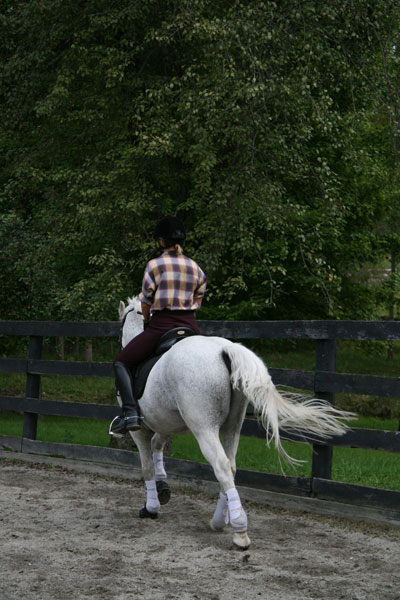Renvers at the trot used to give riders such fits at Second Level that the new round of tests in 2015 moved it to Third Level instead. From what I’ve seen, riders are more comfortable with it there. I really love renvers at the trot for suppling and to improve engagement. However, it was a real shock to my system several years ago when my trainer Jess Rizzi asked me to do renvers in counter-canter.

Try saying that five times fast. Try riding it five times fast. Talk about a tongue-, mind-, leg-twister! The object is to get the horse straighter in the canter for tempi changes and other good things that come from straightness. The first time Jess sprung this one on me, though, she worded it differently, thank goodness: We were in counter-canter and she asked me to change the bend without changing the lead. Piece of cake.
The renvers in counter-canter takes the exercise a big leap forward from the trot version. First you have to be comfortable in counter-canter on straight lines and curves. Okay, so next take that counter-canter down the long side in shoulder-in, which means the haunches are to the inside of the arena and the horse’s cleavage is pointing out. Then you change the bend so that the horse’s cleavage (and yours) is pointing down the line of the arena fence but without losing the lead.
You do it with a slight turn of the wrist, a turn of your shoulders and an increased emphasis with the seat bones but without letting your weight slip to one side or your legs changing position. If this is just too confusing, renvers can be done first in walk and trot before returning to canter and then counter-canter. This exercise, if you think about it too hard, is sort of like rubbing your tummy with one hand, patting your head with the other hand, while rolling your eyes and licking your nose with your tongue, all at the same time.
If renvers in counter-canter sounds looney to figure out, well it’s not that easy for many people at normal sitting trot. It really is a very simple concept – from shoulder-in, just change the bend while staying on the same line. I’d guesstimate that only a quarter of the riders I saw at Second Level got it right, but that’s more like 90% now at Third Level. Sometimes, however, the riders do amazing contortions, and the horses simply get confused and stay in shoulder-in or fall to the inside track and go straight. It’s important to figure this one out, though, because the ability to change the bend on any line and curve, at any gait or lead, is vital to moving forward to the FEI levels.
This is also an exercise that can help with the so-called “Niggli squiggles.” It’s a movement with a 10-meter half circle in true canter that is followed directly by a 10-meter half circle in counter canter. The movement used to be found in Prix St. Georges but disappeared for over a decade. However, it was recalled very fondly, so now it’s again part of our test repertoire, but at Fourth Level Test 3.











